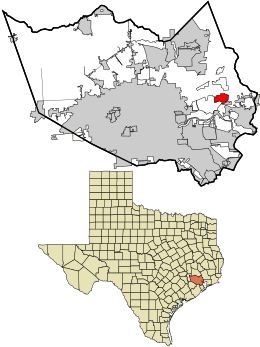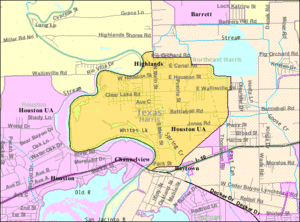Highlands, Texas facts for kids
Quick facts for kids
Highlands, Texas
|
|
|---|---|

Location in Harris County and the state of Texas
|
|
| Country | United States |
| State | Texas |
| County | Harris |
| Area | |
| • Total | 6.5 sq mi (16.9 km2) |
| • Land | 4.9 sq mi (12.6 km2) |
| • Water | 1.7 sq mi (4.3 km2) |
| Elevation | 36 ft (11 m) |
| Population
(2020)
|
|
| • Total | 8,612 |
| • Density | 1,320/sq mi (509.6/km2) |
| Time zone | UTC-6 (Central (CST)) |
| • Summer (DST) | UTC-5 (CDT) |
| ZIP code |
77562
|
| Area code(s) | 281 |
| FIPS code | 48-33836 |
| GNIS feature ID | 1337750 |
Highlands is a community in Harris County, Texas, United States. It is called a census-designated place (CDP). This means it's a special area defined by the government for counting people. Highlands is located along the Union Pacific Railroad. It is north of Interstate 10. You can find it west of Farm to Market Road 2100. This area is part of unincorporated Harris County. This means it is not officially a city with its own local government. In 2020, about 8,612 people lived in Highlands.
Contents
History of Highlands
The community got its name, Highlands, because of its location. The east bank of the San Jacinto River is higher up than the west bank. Highlands sits on this higher ground.
By 1908, Highlands became a stop on the Beaumont, Sour Lake and Western Railway. A post office opened in the community in 1929. Highlands tried to become an official town in 1930. However, its plan was cancelled, and it went back to being an unincorporated area.
In the 1930s, Highlands had about 20 businesses. Its population went down from 350 to 200 people. A map from 1936 showed that Highlands had two churches, a factory, a school, and a sawmill. During World War II, Highlands provided homes for military members and people working in war factories.
By 1948, the community had grown to 3,000 residents and 75 businesses. In the 1950s, local businesses slowed down. The population also dropped to 2,723 people. Another attempt to make Highlands an official town in 1956 did not succeed.
In the 1960s, Highlands was home to a canning sales company and a chemical company. In the early 1960s, about 4,336 people lived there, and it had 82 businesses. In 1965, W. O. Hutson built the Double Trouble Youth Rodeo Arena. By the early 1970s, Highlands had 3,462 residents and 66 businesses. The population grew to 5,000 by 1977 and stayed about the same in 1989. In 1990, the population was estimated to be 6,632 people.
Geography of Highlands
Highlands is located at coordinates 29.816803 degrees North and 95.059362 degrees West.
The United States Census Bureau says that Highlands covers a total area of about 16.9 square kilometers (6.5 square miles). Out of this, 12.6 square kilometers (4.9 square miles) is land. The remaining 4.3 square kilometers (1.7 square miles), which is about 25% of the total, is water.
Highlands is situated on the banks of the San Jacinto River. It is also near the Houston Ship Channel. Most of the land in Highlands is on a high river bank, which is why it's called "Highlands." The historic Lynchburg Ferry is also located nearby.
Population Information
| Historical population | |||
|---|---|---|---|
| Census | Pop. | %± | |
| 1950 | 2,725 | — | |
| 1960 | 4,336 | 59.1% | |
| 1970 | 3,462 | −20.2% | |
| 1980 | 6,467 | 86.8% | |
| 1990 | 6,632 | 2.6% | |
| 2000 | 7,089 | 6.9% | |
| 2010 | 7,522 | 6.1% | |
| 2020 | 8,612 | 14.5% | |
| U.S. Decennial Census 1850–1900 1910 1920 1930 1940 1950 1960 1970 1980 1990 2000 2010 2020 |
|||
Highlands was first listed as an unincorporated community in the 1950 U.S. Census. It became a census-designated place (CDP) in the 1980 U.S. Census.
2020 Census Details
The table below shows the different groups of people living in Highlands. It helps us understand the community's makeup.
| Race / Ethnicity (NH = Non-Hispanic) | Pop 2000 | Pop 2010 | Pop 2020 | % 2000 | % 2010 | % 2020 |
|---|---|---|---|---|---|---|
| White alone (NH) | 5,929 | 5,280 | 4,564 | 83.64% | 70.19% | 53.00% |
| Black or African American alone (NH) | 112 | 229 | 335 | 1.58% | 3.04% | 3.89% |
| Native American or Alaska Native alone (NH) | 29 | 40 | 35 | 0.41% | 0.53% | 0.41% |
| Asian alone (NH) | 27 | 27 | 40 | 0.38% | 0.36% | 0.46% |
| Pacific Islander alone (NH) | 1 | 0 | 1 | 0.01% | 0.00% | 0.01% |
| Other Race alone (NH) | 0 | 9 | 22 | 0.00% | 0.12% | 0.26% |
| Mixed race or Multiracial (NH) | 69 | 70 | 271 | 0.97% | 0.93% | 3.15% |
| Hispanic or Latino (any race) | 922 | 1,867 | 3,344 | 13.01% | 24.82% | 38.83% |
| Total | 7,089 | 7,522 | 8,612 | 100.00% | 100.00% | 100.00% |
In 2020, there were 8,612 people living in Highlands. There were 2,547 households and 1,766 families.
Back in 2000, there were 7,089 people and 2,564 households. About 37.3% of these households had children under 18. Most households (59.7%) were married couples. About 11.9% had a female head of household without a husband. About 22.9% were not families.
The average household had 2.75 people, and the average family had 3.14 people. The population was spread out by age. About 27.8% were under 18. About 10.8% were 65 or older. The average age was 36 years.
In 2000, the average income for a household was $41,288. For a family, it was $49,655. About 9.8% of the population lived with lower incomes. This included 13.0% of those under 18.
Education in Highlands
Public Schools
Students in Highlands usually go to schools in the Goose Creek Consolidated Independent School District. A small part of the community is also in the Deer Park Independent School District.
Schools located in Highlands include:
- Bonnie P. Hopper Elementary School (for grades PK-1)
- Highlands Elementary School (for grades 2-5)
- Highlands Junior High School (for grades 6-8)
Some areas with Highlands addresses, but not in the CDP, are served by Harlem Elementary School (PK-5). For high school, students go to Goose Creek Memorial High School.
Harlem Elementary was first built in 1923. Highlands Elementary School opened in 1926. It joined the Goose Creek district in 1928. Highlands Junior High School has been around since 1958. Hopper Elementary opened in 1980. The current building for Harlem was built in 1992. Highlands Elementary's current campus also opened in 1992. Highlands Junior High's current campus was built with money from a 2005 bond. Goose Creek Memorial High School opened its doors on August 25, 2008.
Private Schools
The Chinquapin School is a private school for students from lower-income families. It is located east of the Highlands CDP. The school first opened in 1969.
Public Libraries
Highlands has its own public library, the Stratford Branch Library. It is part of the Harris County Public Library system. The library is located at 509 Stratford Street. It first opened in 1966 in a small building. A woman named Anna Stratford gave the land for the library. In 1985, the library was made bigger.
Parks and Recreation
Highlands has several places for fun and outdoor activities. Precinct 2 manages the Highlands Park and two community centers. These are the Highlands and San Jacinto Community Centers. They are located at 604 Highlands Woods Drive.
Highlands Park offers many features:
- A picnic area
- A playground
- A lighted walking trail
- An open shelter
- A lighted basketball court
- A lighted tennis court
- A covered barbecue pit
- An exercise station
- A spray park for cooling off
- Toilets
Stratford Park and the Stratford Library are at 509 Stratford Street. Stratford Park has a picnic area, a playground, an open shelter, a lighted baseball field, and toilets.
Transportation
Harris County Transit provides public transportation services in Highlands.
Notable People from Highlands
Highlands is the hometown of some well-known people:
- T. J. Ford: A former professional basketball player who played in the NBA.
- Robert Francois: A linebacker who played for the Green Bay Packers football team.
Also, the main characters from the TV show Beavis and Butt-head live in a made-up community called Highland, Texas.
See also
 In Spanish: Highlands (Texas) para niños
In Spanish: Highlands (Texas) para niños


